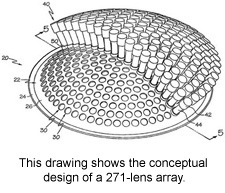 |
|
It was David Pollock who first discovered that if you point a large number of lenses toward a common point, and then make a small correction on each of the lenses, you provide a camera with capabilities that far surpass existing technologies.
Ultimately the camera can cover nearly a hemispherical field-of-view with uniform image quality and sensitivity. The initial camera design constraint was to obtain greater than 109 samples within a 10 x 10 km ground footprint. It was quickly realized that with 4 mega-samples (mega-pixel) per camera this would require 271 cameras. The constraint leads to significant, greater than 90 percent sample redundancy.
Reducing the redundancy to less than 1 percent significantly expands the field-of-view, Pollock said. Further, because of the modular nature, the field-of-view can be configured to suit specific applications.
UAHuntsville filed the patent for the large-format giga-pixel camera and shares that patent on a 50-50 basis with Sony.
Cripes. Probably uses a yardstick-sized memory stick.















Who needs God or Santa looking over your shoulder when you have GigaPixel Big Brother. I swear it is enough to make you WANT to wear a camouflaged burka.
Good.
More expensive toys to break when the revolution comes.
Who needs Bug Eyed Monsters from Outer Space, when we got Bug Eyed Butt Wads here already?
These folks probably “deserve” to be partnered with Sony.
New, kick-ass technology. Cool.